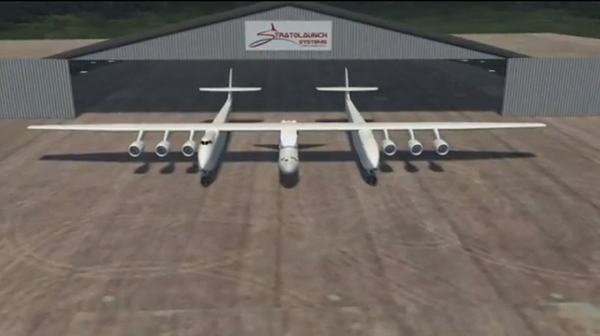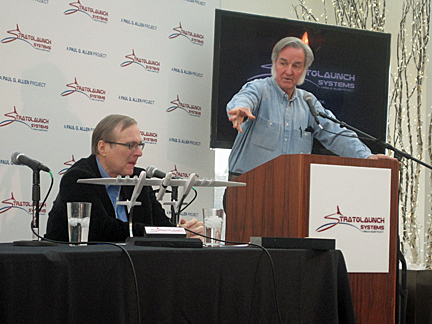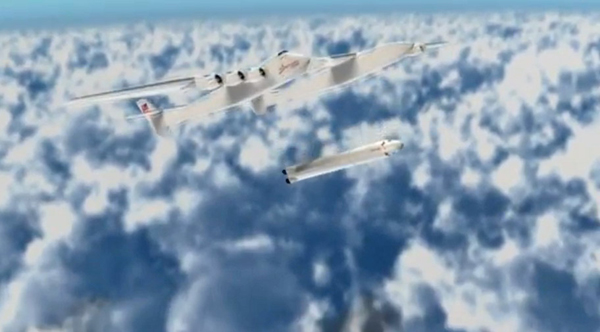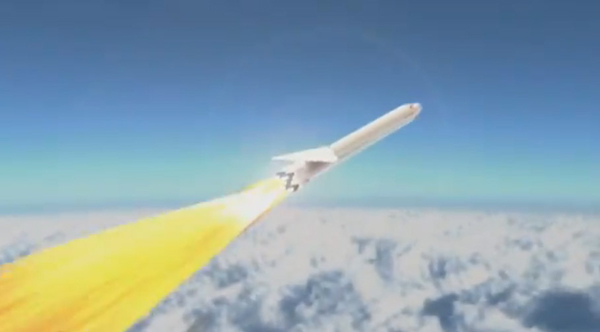Paul Allen, Burt Rutan unveil new air-launch rocket system
12/13/2011 06:25 PM Filed in: Space News | Commercial Space
By WILLIAM HARWOOD
CBS News
SEATTLE--Microsoft co-founder Paul Allen and legendary aircraft designer Burt Rutan have teamed up for a new winged rocket that would be carried aloft by a gargantuan twin fuselage mothership and then dropped from 30,000 feet for the climb to orbit, they announced Tuesday.
The new rocket will be funded by Allen through a new company known as Stratolaunch and built by Space Exploration Technologies Corp., or SpaceX, of Hawthorne, Calif.
The 1.2-million-pound six-engine carrier aircraft, with a wingspan of 385 feet, will be built by Scaled Composites of Mojave, Calif., a company founded by Rutan and now owned by Northrop Grumman. Dynetics of Huntsville, Ala., will provide program management and engineering support, along with the hardware used to attach the rocket to the carrier plane.
Allen, who funded Rutan's development of a small piloted spaceplane built by Scaled that won a $10 million prize in 2004 for becoming the first private-sector manned craft to reach space, said his goal is to lower the cost of launching payloads -- and eventually people -- into low-Earth orbit.
"Our national aspirations for space exploration have been receding," he said during a news conference. "This year saw the end of NASA's space shuttle program. Constellation, which would have taken us back to the moon, has been mothballed as well. For the first time since John Glenn, America cannot fly its own astronauts into space.
"With government-funded spaceflight diminishing, there's a much expanded opportunity for privately funded efforts. ... Today, we stand at the dawn of a radical change in the space launch industry. Stratolaunch will build an air-launch system to give us orbital access to space with greater safety, flexibility and cost effectiveness, both for cargo and for manned missions."
While saying the company faces technical challenges, "by the end of this decade, Stratolaunch will be putting spacecraft into orbit," Allen said. "It will keep America at the forefront of space exploration and give tomorrow's children something to search for in the night sky and dream about. Work has already started on our project at the Mojave Spaceport."
The 120-foot-long two-stage SpaceX rocket will weigh about 490,000 pounds at launch and will be capable of boosting about 13,500 pounds to low-Earth orbit, roughly the same throw weight as a United Launch Alliance Delta 2 rocket.
In the near term, the rocket can be used to launch medium-class commercial, NASA and military satellites into orbit. Eventually, company officials envision using the new system to launch manned capsules into orbit.
"Certainly at some point ... there is the capability of this vehicle to loft a medium-size crew, say six people," said Mike Griffin, former NASA administrator and a member of the Stratolaunch board. "This vehicle has the inherent capability to do that. Whether they would visit the space station or visit another yet-to-be-developed facility or just go into space for a few days and come back, I think those scenarios are not laid out yet."
By launching the rocket in mid air, Stratolaunch will be able to avoid weather delays and ground-processing issues, sending satellites to any desired orbit.
But getting a half-million-pound rocket to an altitude of 30,000 feet will require a truly gargantuan carrier aircraft, a twin-fuselage plane that will be one of the largest flying machines ever built.
The Russian Antonov AN-225 cargo plane, the largest operational aircraft in the world, has a wingspan of 290 feet and weighs 1.3 million pounds. Howard Hughes' flying boat, the "Spruce Goose," had a wingspan of 320 feet.
The carrier aircraft envisioned by Scaled Composites will have an even larger wingspan and incorporate systems taken from two 747 jumbo jets. It is similar in appearance to a vastly scaled up version of a system funded by Allen and designed by Rutan as part of the Ansari X-Prize competition.
After winning the X-Prize, Rutan designed a larger, seven-seat version of SpaceShipOne for Richard Branson's Virgin Galactic, which hopes to begin carrying paying customers on relatively short up-and-down sub-orbital flights next year.
Some 500 well-heeled would-be astronauts have reserved seats with Virgin, at $200,000 a ticket, looking forward to the adrenalin rush of launch, five to eight minutes of weightlessness and an out-of-this-world view before re-entry and landing at a New Mexico spaceport.
But Allen's rocket is bound for orbit, raising the bar for space tourism and commercial manned spaceflight in general.
"Paul and I pioneered private space travel with SpaceShipOne, which led to Virgin Galactic's commercial suborbital SpaceShipTwo program," Rutan said in a statement. "Now, we will have the opportunity to extend that capability to orbit and beyond. ... We are well aware of the challenges ahead, but we have put together an incredible research team that will draw inspiration from Paul's vision."
Rutan will serve as a member of the Stratolaunch board of directors, acting in an advisory capacity. While the carrier aircraft is based on design studies he carried out over the past two decades, he does not plan to take an active role in the new aircraft's construction.
"I did concept work myself and preliminary design work myself for the last 23 years or so," he told reporters Tuesday. "However, I'm not the responsible designer. I've actually retired. I don't even show up at work anymore."
Asked to provide specifics about the aircraft's capabilities, Rutan declined, saying "I don't think it's wise for this program ... to give the competition our technical numbers."
"It doesn't make sense to me that we would share our technical information with folk who might be competitors of ours until we have to share it," he said. "We have to share it after it's flying, but we don't have to now."
Allen believes the Stratolaunch rocket is a potential game changer, to use NASA Administrator Charles Bolden's pet phrase for the Obama administration's commercial space policy, offering an alternative route to orbit for private companies, universities and, eventually, space tourists.
NASA is partially funding a competition to develop new private-sector launch systems to carry astronauts to and from the International Space Station.
Critics, including Griffin, have questioned whether NASA's commercial space initiative can succeed in the absence of a clearly defined business plan. NASA only plans two or three flights a year to the space station and it's not clear how companies can profit with such a low flight rate in the absence of any other destinations.
One of the competitors -- Boeing -- hopes to eventually use the CST-100 spacecraft it is developing for NASA missions to carry researchers, tourists and others to a commercial space station planned by Bigelow Aerospace of Las Vegas, Nev. Having a second destination is viewed as critical to the program's long-term success, allowing a higher flight rate.
But the Stratolaunch venture is fundamentally different, Griffin said in an interview, in large part because Allen brings the long-term financial commitment necessary to weather failures.
"Why do I think this venture can be a success? I think the crucial factors for any putative commercial space venture are the necessary financial wherewithal to sustain what will inevitably be a lengthy development process relative to other typical market items, and the vision and the resolve to fly through the developmental failures, which inevitably occur," Griffin said.
"I think Paul Allen has demonstrated already ... both of those qualities. I think that makes the crucial difference. In the end, the business case will be dominated by the long-run market and I think it remains for all of us to see what the market for space transportation could be when the operations are more cost effective."
The rocket will be built at the SpaceX factory in Hawthorne, Calif. The carrier aircraft will be built by Scaled Composites in a new hangar at the Mojave Spaceport that is already under construction. The aircraft will need a 12,000-foot-long runway and it will have the ability to fly some 1,300 miles to reach an appropriate launch site.
"Scaled is all about achieving milestones and pursuing breakthroughs, and this project offers both -- building the largest airplane in the world, and achieving the manufacturing breakthroughs that will enable Scaled to accomplish it," Doug Shane, president of Scaled Composites, said in a news release.
"We are thrilled to be a part of this development program. We anticipate significant hiring of engineering, manufacturing, and support staff in the near and medium term."
As for the rocket, SpaceX already holds contracts valued at some $1.6 billion to deliver cargo to the space station using the company's Falcon 9 booster and Dragon capsules. A second test flight is planned for Feb. 7, with the start of routine cargo deliveries expected later next year.
SpaceX also is competing to build a manned spacecraft as part of a NASA competition to develop private-sector access to space in the wake of the space shuttle's retirement.
That effort is independent of the Stratolaunch initiative. The new rocket is a less-powerful version of the Falcon 9 used for NASA missions and does not compete for the same family of payloads.
Griffin said the new system is an evolutionary, not revolutionary, step forward. But air launch offers clear advantages that will help ensure success, including quick turnaround.
"It's an approach that offers some very substantial operational flexibility, much reduced (launch site) requirements, freedom from a lot of the limitations that come from launching with land-based ranges, the ability to deal with weather scenarios that we can't when we're parked at Vandenberg (Air Force Base, Calif.) or the Cape."
But it also comes with its own limitations.
"Payloads will have trouble growing (in size)," Griffin said. "The airplane is as big as the airplane is, so it has its plusses and minuses. It's a little bit different from what folks are used to seeing. But it is not a new concept, it is not untried and it's one that we think will offer some significant operational efficiencies."
CBS News
SEATTLE--Microsoft co-founder Paul Allen and legendary aircraft designer Burt Rutan have teamed up for a new winged rocket that would be carried aloft by a gargantuan twin fuselage mothership and then dropped from 30,000 feet for the climb to orbit, they announced Tuesday.
The new rocket will be funded by Allen through a new company known as Stratolaunch and built by Space Exploration Technologies Corp., or SpaceX, of Hawthorne, Calif.
The 1.2-million-pound six-engine carrier aircraft, with a wingspan of 385 feet, will be built by Scaled Composites of Mojave, Calif., a company founded by Rutan and now owned by Northrop Grumman. Dynetics of Huntsville, Ala., will provide program management and engineering support, along with the hardware used to attach the rocket to the carrier plane.
 |
| The Stratolaunch carrier airplane rolls out of the hangar in this animation still. (Credit: Stratolaunch) |
Allen, who funded Rutan's development of a small piloted spaceplane built by Scaled that won a $10 million prize in 2004 for becoming the first private-sector manned craft to reach space, said his goal is to lower the cost of launching payloads -- and eventually people -- into low-Earth orbit.
"Our national aspirations for space exploration have been receding," he said during a news conference. "This year saw the end of NASA's space shuttle program. Constellation, which would have taken us back to the moon, has been mothballed as well. For the first time since John Glenn, America cannot fly its own astronauts into space.
"With government-funded spaceflight diminishing, there's a much expanded opportunity for privately funded efforts. ... Today, we stand at the dawn of a radical change in the space launch industry. Stratolaunch will build an air-launch system to give us orbital access to space with greater safety, flexibility and cost effectiveness, both for cargo and for manned missions."
While saying the company faces technical challenges, "by the end of this decade, Stratolaunch will be putting spacecraft into orbit," Allen said. "It will keep America at the forefront of space exploration and give tomorrow's children something to search for in the night sky and dream about. Work has already started on our project at the Mojave Spaceport."
The 120-foot-long two-stage SpaceX rocket will weigh about 490,000 pounds at launch and will be capable of boosting about 13,500 pounds to low-Earth orbit, roughly the same throw weight as a United Launch Alliance Delta 2 rocket.
 |
| Paul Allen, left, and aircraft designer Burt Rutan describe the new Stratolaunch rocket system to reporters in Seattle. (Credit: William Harwood/CBS News) |
"Certainly at some point ... there is the capability of this vehicle to loft a medium-size crew, say six people," said Mike Griffin, former NASA administrator and a member of the Stratolaunch board. "This vehicle has the inherent capability to do that. Whether they would visit the space station or visit another yet-to-be-developed facility or just go into space for a few days and come back, I think those scenarios are not laid out yet."
By launching the rocket in mid air, Stratolaunch will be able to avoid weather delays and ground-processing issues, sending satellites to any desired orbit.
But getting a half-million-pound rocket to an altitude of 30,000 feet will require a truly gargantuan carrier aircraft, a twin-fuselage plane that will be one of the largest flying machines ever built.
The Russian Antonov AN-225 cargo plane, the largest operational aircraft in the world, has a wingspan of 290 feet and weighs 1.3 million pounds. Howard Hughes' flying boat, the "Spruce Goose," had a wingspan of 320 feet.
The carrier aircraft envisioned by Scaled Composites will have an even larger wingspan and incorporate systems taken from two 747 jumbo jets. It is similar in appearance to a vastly scaled up version of a system funded by Allen and designed by Rutan as part of the Ansari X-Prize competition.
After winning the X-Prize, Rutan designed a larger, seven-seat version of SpaceShipOne for Richard Branson's Virgin Galactic, which hopes to begin carrying paying customers on relatively short up-and-down sub-orbital flights next year.
Some 500 well-heeled would-be astronauts have reserved seats with Virgin, at $200,000 a ticket, looking forward to the adrenalin rush of launch, five to eight minutes of weightlessness and an out-of-this-world view before re-entry and landing at a New Mexico spaceport.
 |
| The SpaceX rocket will be dropped from the carrier aircraft at an altitude of 30,000 feet. (Credit: Stratolaunch) |
But Allen's rocket is bound for orbit, raising the bar for space tourism and commercial manned spaceflight in general.
"Paul and I pioneered private space travel with SpaceShipOne, which led to Virgin Galactic's commercial suborbital SpaceShipTwo program," Rutan said in a statement. "Now, we will have the opportunity to extend that capability to orbit and beyond. ... We are well aware of the challenges ahead, but we have put together an incredible research team that will draw inspiration from Paul's vision."
Rutan will serve as a member of the Stratolaunch board of directors, acting in an advisory capacity. While the carrier aircraft is based on design studies he carried out over the past two decades, he does not plan to take an active role in the new aircraft's construction.
"I did concept work myself and preliminary design work myself for the last 23 years or so," he told reporters Tuesday. "However, I'm not the responsible designer. I've actually retired. I don't even show up at work anymore."
Asked to provide specifics about the aircraft's capabilities, Rutan declined, saying "I don't think it's wise for this program ... to give the competition our technical numbers."
"It doesn't make sense to me that we would share our technical information with folk who might be competitors of ours until we have to share it," he said. "We have to share it after it's flying, but we don't have to now."
Allen believes the Stratolaunch rocket is a potential game changer, to use NASA Administrator Charles Bolden's pet phrase for the Obama administration's commercial space policy, offering an alternative route to orbit for private companies, universities and, eventually, space tourists.
NASA is partially funding a competition to develop new private-sector launch systems to carry astronauts to and from the International Space Station.
Critics, including Griffin, have questioned whether NASA's commercial space initiative can succeed in the absence of a clearly defined business plan. NASA only plans two or three flights a year to the space station and it's not clear how companies can profit with such a low flight rate in the absence of any other destinations.
One of the competitors -- Boeing -- hopes to eventually use the CST-100 spacecraft it is developing for NASA missions to carry researchers, tourists and others to a commercial space station planned by Bigelow Aerospace of Las Vegas, Nev. Having a second destination is viewed as critical to the program's long-term success, allowing a higher flight rate.
But the Stratolaunch venture is fundamentally different, Griffin said in an interview, in large part because Allen brings the long-term financial commitment necessary to weather failures.
 |
| Similar to an Orbital Sciences Pegasus air-launch rocket, the SpaceX version would use a stabilizing wing for the powered climb to space. (Credit: Stratolaunch) |
"Why do I think this venture can be a success? I think the crucial factors for any putative commercial space venture are the necessary financial wherewithal to sustain what will inevitably be a lengthy development process relative to other typical market items, and the vision and the resolve to fly through the developmental failures, which inevitably occur," Griffin said.
"I think Paul Allen has demonstrated already ... both of those qualities. I think that makes the crucial difference. In the end, the business case will be dominated by the long-run market and I think it remains for all of us to see what the market for space transportation could be when the operations are more cost effective."
The rocket will be built at the SpaceX factory in Hawthorne, Calif. The carrier aircraft will be built by Scaled Composites in a new hangar at the Mojave Spaceport that is already under construction. The aircraft will need a 12,000-foot-long runway and it will have the ability to fly some 1,300 miles to reach an appropriate launch site.
"Scaled is all about achieving milestones and pursuing breakthroughs, and this project offers both -- building the largest airplane in the world, and achieving the manufacturing breakthroughs that will enable Scaled to accomplish it," Doug Shane, president of Scaled Composites, said in a news release.
"We are thrilled to be a part of this development program. We anticipate significant hiring of engineering, manufacturing, and support staff in the near and medium term."
As for the rocket, SpaceX already holds contracts valued at some $1.6 billion to deliver cargo to the space station using the company's Falcon 9 booster and Dragon capsules. A second test flight is planned for Feb. 7, with the start of routine cargo deliveries expected later next year.
SpaceX also is competing to build a manned spacecraft as part of a NASA competition to develop private-sector access to space in the wake of the space shuttle's retirement.
That effort is independent of the Stratolaunch initiative. The new rocket is a less-powerful version of the Falcon 9 used for NASA missions and does not compete for the same family of payloads.
Griffin said the new system is an evolutionary, not revolutionary, step forward. But air launch offers clear advantages that will help ensure success, including quick turnaround.
"It's an approach that offers some very substantial operational flexibility, much reduced (launch site) requirements, freedom from a lot of the limitations that come from launching with land-based ranges, the ability to deal with weather scenarios that we can't when we're parked at Vandenberg (Air Force Base, Calif.) or the Cape."
But it also comes with its own limitations.
"Payloads will have trouble growing (in size)," Griffin said. "The airplane is as big as the airplane is, so it has its plusses and minuses. It's a little bit different from what folks are used to seeing. But it is not a new concept, it is not untried and it's one that we think will offer some significant operational efficiencies."